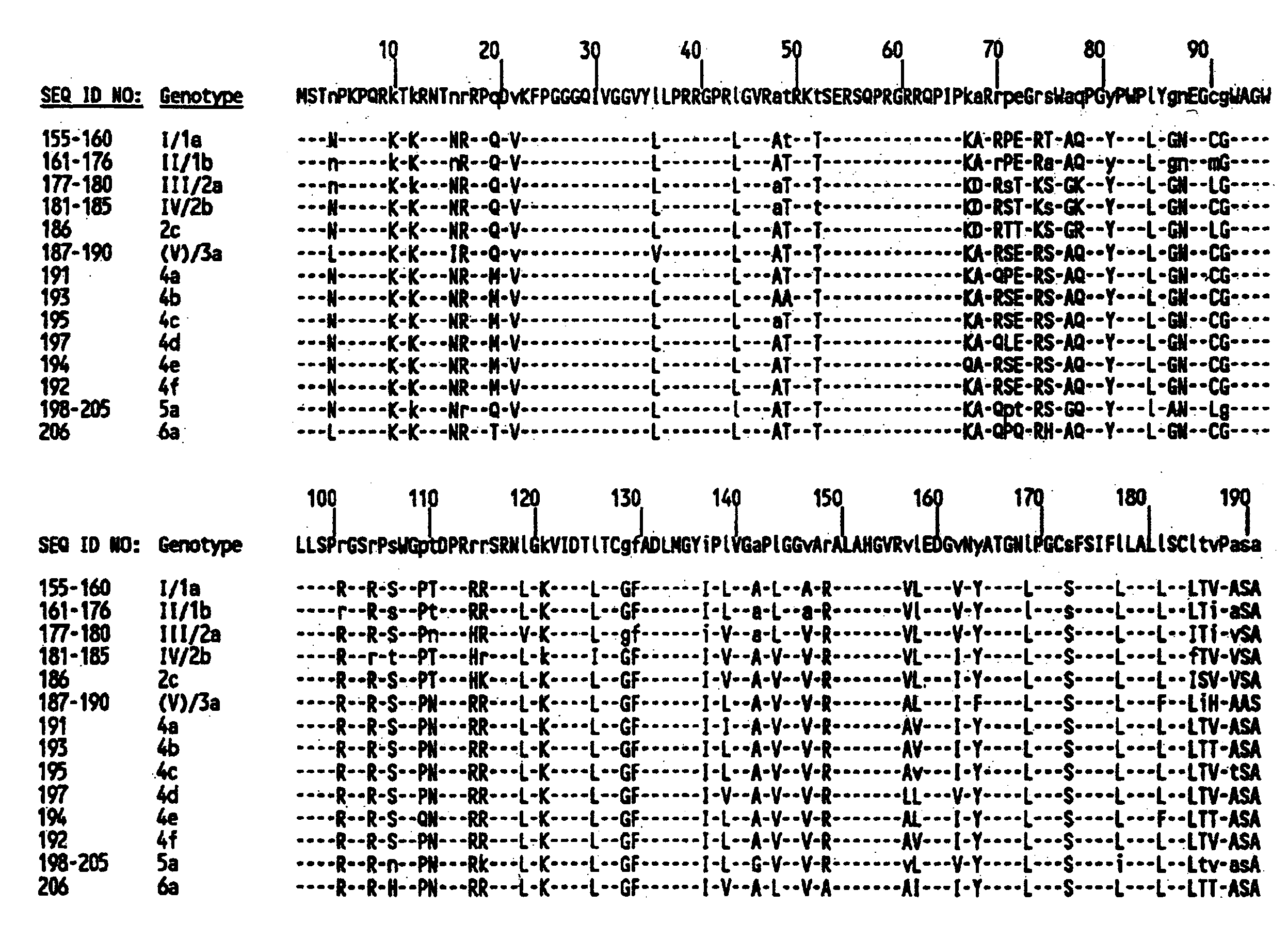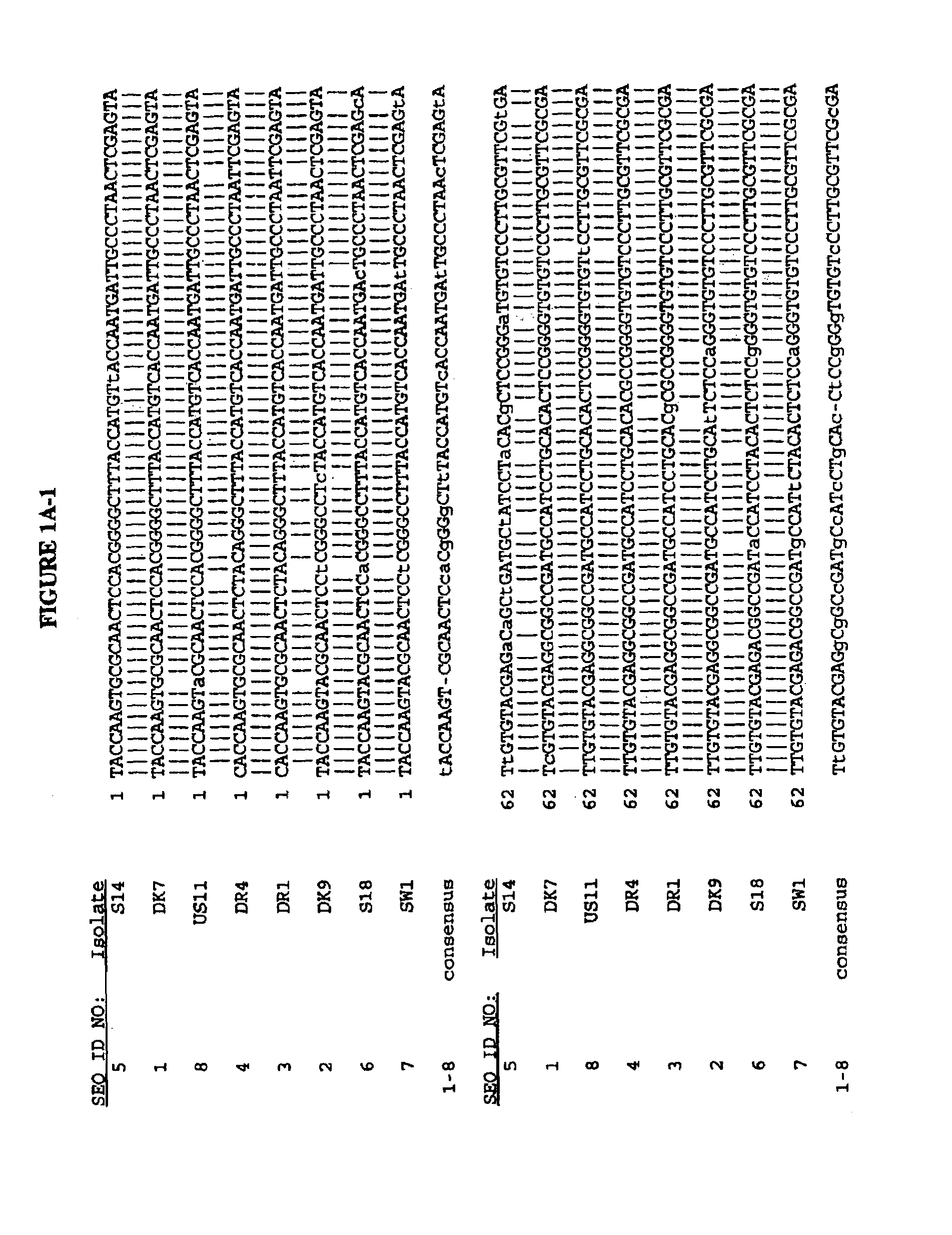Nucleotide and deduced amino acid sequences of the envelope 1 and core genes of isolates of hepatitis C virus and the use of reagents derived from these sequences in diagnostic methods and vaccines
a technology of hepatitis c virus and amino acid sequences, which is applied in the field of hepatitis virology, can solve the problems of infection with one strain and not protecting against infection with the other strain, and the success of chimpanzees from hepatitis c infection via recombinant vaccine administration has been limited, so as to achieve the effect of preventing or treating hepatitis
- Summary
- Abstract
- Description
- Claims
- Application Information
AI Technical Summary
Benefits of technology
Problems solved by technology
Method used
Image
Examples
example 1
Identification of the cDNA Sequence of the E1 Gene of 51 Isolates of HCV via RT-PCR Analysis of Viral RNA Using Universal Primers
[0199]Viral RNA was extracted from 100 μl of serum by the guanidinium-phenol-chloroform method and the final RNA solution was divided into 10 equal aliquots and stored at −80° C. as described (Bukh, et al. (1992 (a)). The sequences of the synthetic oligonucleotides used in the RT-PCR assay, deduced from the sequence of HCV strain H-77 (Ogata, N. et al. (1991) Proc. Natl. Acad. Sci. USA 88:3392–3396), are shown as SEQ ID NOs:207–212. One aliquot of the final RNA solution, equivalent to 10 μl of serum, was used for cDNA synthesis that was performed in a 20 μl reaction mixture using avian myeloblastosis virus reverse transcriptase (Promega, Madison, Wis.) and SEQ ID NO:208 as a primer. The resulting cDNA was amplified in a “nested” PCR assay by Taq DNA polymerase (Amplitaq, Perkin-Elmer / Cetus) as described previously (Bukh et al. (1992a)) with primer set e (S...
example 2
Computer Analysis of the Nucleotide and Deduced Amino Acid Sequences of the E1 Gene of 51 HCV Isolates
[0200]Multiple computer-generated alignments of the nucleotide (SEQ ID NOs:1–51, FIGS. 1A–H) and deduced amino acid sequences (SEQ ID NOs:52–102, FIGS. 2A–H) of the cDNAs of the 51 HCV isolates constructed using the computer program GENALIGN (Miller, R. H. et al. (1990) Proc. Natl. Acad. Sci. USA 87:2057–2061) resulted in the 51 HCV isolates being divided into twelve genotypes based upon the degree of variation of the E1 gene sequence as shown in table 1.
Biochemistry: Bukh et al.
[0201]
TABLE 1Percent nucleotide (nt) and amino acid (aa) sequence identify of the E1 gene among the 12 HCV genotypes.I / 1aII / 1bIII / 2aIV / 2b2c(V) / 3a4a4b4c4d5a6ant:89.9–97.672.0–76.259.2–63.756.1–58.360.8–62.863.0–66.363.9–67.264.9–66.862.7–64.467.7–62.3–62.2–I / 1a69.467.263.9aa:88.9–97.958.3–62.253.8–57.560.1–61.563.9–67.260.9–63.763.4–65.861.6–65.163.0–62.2–61.6–II / 1b65.566.563.0I / 1a91.1–98.488.0–91.369.1–71.07...
example 3
Identification of the cDNA Sequence of the Core Gene of 52 Isolates of HCV
[0208]Viral RNA extraction, cDNA synthesis and “nested” PCR were carried out as in Example 1. For the cDNA PCR assay HCV-specific synthetic oligonucleotides deduced from previously determined sequences that flank the C gene were used. Amplified DNA was purified by gel electrophoresis followed by glass-milk extraction as described in Example 1 or by electroelution and both strands were sequenced directly. In 44 of the 52 HCV isolates studied the procedures for direct sequencing described in Example 1 were utilized. For a number of the HCV isolates confirmatory sequencing was performed with the Applied Biosystems 373A automated DNA sequencer and 8 HCV isolates of genotype I / 1a or II / 1b were sequenced exclusively by this method. All 73 negative control samples interspersed among the test samples were negative for HCV RNA.
[0209]The amplified DNA fragment obtained in 50 of the 52 HCV isolates was specifically desig...
PUM
| Property | Measurement | Unit |
|---|---|---|
| pH | aaaaa | aaaaa |
| pH | aaaaa | aaaaa |
| pH | aaaaa | aaaaa |
Abstract
Description
Claims
Application Information
 Login to View More
Login to View More - R&D
- Intellectual Property
- Life Sciences
- Materials
- Tech Scout
- Unparalleled Data Quality
- Higher Quality Content
- 60% Fewer Hallucinations
Browse by: Latest US Patents, China's latest patents, Technical Efficacy Thesaurus, Application Domain, Technology Topic, Popular Technical Reports.
© 2025 PatSnap. All rights reserved.Legal|Privacy policy|Modern Slavery Act Transparency Statement|Sitemap|About US| Contact US: help@patsnap.com



